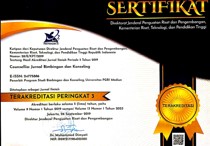Addiction Counselor Profession: Perception of Family Support for Recovering from Drug Abuse Addiction
Abstract
Keywords
Full Text:
PDFReferences
Ali, M. M., Dean Jr, D., Lipari, R., Dowd, W. N., Aldridge, A. P., & Novak, S. P. (2015). The mental health consequences of nonmedical prescription drug use among adolescents. J Ment Health Policy Econ, 18(1), 3–15.
BACHTIAR, I. (2018). REHABILITASI BAGI PECANDU NARKOBA DI YAYASAN AN-NUR BALAI PENGOBATAN/WISMA REHABILITASI KH SUPONO MUSTAJAB KABUPATEN PURBALINGGA [PhD Thesis]. IAIN.
Bakri, N., & Barmawi, B. (2017). Efektifitas Rehabilitasi Pecandu Narkotika Melalui Terapi Islami di Badan Narkotika Nasional (BNN) Banda Aceh. Psikoislamedia: Jurnal Psikologi, 2(1), 86–95.
Beni, H., & Aryanie, D. (2019). Dampak Konseling Adiksi terhadap Klien Pasca Rehabilitasi Narkoba di Yayasan Pradita Madani Cempaka Kec. Kedawung Kab. Cirebon. Prophetic: Professional, Empathy and Islamic Counseling Journal, 2(2), 243–254.
Best, D., Beckwith, M., Haslam, C., Alexander Haslam, S., Jetten, J., Mawson, E., & Lubman, D. I. (2016). Overcoming alcohol and other drug addiction as a process of social identity transition: The social identity model of recovery (SIMOR). Addiction Research & Theory, 24(2), 111–123.
Canavan, J., Dolan, P., & Pinkerton, J. (2000). Family support: Direction from diversity. Jessica Kingsley Publishers.
Chii, C. Y., Seok, C. B., & Sombuling, A. (2017). PRECEIVED SOCIAL SUPPORT AND GLOBAL SELF-WORTH IN ADOLESCENCE. JURNAL PSIKOLOGI MALAYSIA, 31(1).
Chung, Y. Y., & Shek, D. T. (2018). Treatment fears: Barriers to young psychotropic substance abusers receiving residential drug rehabilitation treatment. International Journal of Mental Health and Addiction, 16(6), 1322–1342.
Claro, H. G., Oliveira, M. A. F. de, Titus, J. C., Fernandes, I. F. de A. L., Pinho, P. H., & Tarifa, R. R. (2015). Drug use, mental health and problems related to crime and violence: Cross-sectional study. Revista Latino-Americana de Enfermagem, 23(6), 1173–1180.
Cullen, F. T., & Jonson, C. L. (2011). Rehabilitation and treatment programs. Crime and Public Policy, 293–344.
De Costa, A. S. (2019). Drug Rehabilitation: Is it effective in decreasing the drug epidemic on Long Island, New York.
de Lange, F. P., Heilbron, M., & Kok, P. (2018). How do expectations shape perception? Trends in Cognitive Sciences, 22(9), 764–779.
Dodge, K., Krantz, B., & Kenny, P. J. (2010). How can we begin to measure recovery? Substance Abuse Treatment, Prevention, and Policy, 5(1), 31.
El-Guebaly, N. (2012). The meanings of recovery from addiction: Evolution and promises. Journal of Addiction Medicine, 6(1), 1–9.
Eliza, D. N. (2018). Social Control of the Family on Juvenile Post-Drug Rehabilitation Relapse Behavior. MASYARAKAT: Jurnal Sosiologi, 101–122.
Enoch, M.-A. (2011). The role of early life stress as a predictor for alcohol and drug dependence. Psychopharmacology, 214(1), 17–31.
Farozin, M., & Kurniawan, L. (2019). Developing Learning Guidance and Counseling Program Based on Social and Emotional Learning in Senior High School. Jurnal Kajian Bimbingan Dan Konseling, 4(2), 47–52.
Fernández-Serrano, M. J., Lozano, Ó., Pérez-García, M., & Verdejo-García, A. (2010). Impact of severity of drug use on discrete emotions recognition in polysubstance abusers. Drug and Alcohol Dependence, 109(1–3), 57–64.
Gideon, L. (2010). Drug offenders’ perceptions of motivation: The role of motivation in rehabilitation and reintegration. International Journal of Offender Therapy and Comparative Criminology, 54(4), 597–610.
Gossop, M. (2013). Living with drugs. Ashgate Publishing, Ltd.
Gray, H. M., Gray, K., & Wegner, D. M. (2007). Dimensions of mind perception. Science, 315(5812), 619–619.
Griffin, K. W., & Botvin, G. J. (2010). Evidence-based interventions for preventing substance use disorders in adolescents. Child and Adolescent Psychiatric Clinics, 19(3), 505–526.
Gustafson, D. H., Shaw, B. R., Isham, A., Baker, T., Boyle, M. G., & Levy, M. (2011). Explicating an evidence-based, theoretically informed, mobile technology-based system to improve outcomes for people in recovery for alcohol dependence. Substance Use & Misuse, 46(1), 96–111.
Han, B. A. O. (2018). Medicalization of Drug Rehabilitation and Future of the China’s Drug Rehabilitation System. Journal of Henan Police College, 1, 5.
Harnad, S. (2003). Categorical perception.
Henggeler, S. W., & Sheidow, A. J. (2012). Empirically supported family-based treatments for conduct disorder and delinquency in adolescents. Journal of Marital and Family Therapy, 38(1), 30–58.
Hughes, C. E., & Stevens, A. (2010). What can we learn from the Portuguese decriminalization of illicit drugs? The British Journal of Criminology, 50(6), 999–1022.
Jia, D., Jiang, Z., Zhang, Y., Wang, J., Zhou, Y., Ma, L., & Guo, S. (2019). The Development Trends in Drug Rehabilitation in China’s Judicial Administration Department. Beijing Law Review, 10(1), 239–245.
Kartono, M. (2005). Perbandingan perilaku agresif antara remaja yang berasal dari keluarga bercerai dengan keluarga utuh. Jurnal Psikologi Vol, 3(1), 1.
Kencana, A. S. (2016). Implementasi Kebijakan Pencegahan Pemberantasan Penyalahgunaan dan Peredaran Gelap Narkoba (P4GN) Pada Bidang Rehabilitasi Badan Narkotika Nasional Kota Surabaya [PhD Thesis]. Universitas Airlangga.
Kerrison, E. M. (2018). Exploring how prison-based drug rehabilitation programming shapes racial disparities in substance use disorder recovery. Social Science & Medicine, 199, 140–147.
Keyes, K. M., Hatzenbuehler, M. L., McLaughlin, K. A., Link, B., Olfson, M., Grant, B. F., & Hasin, D. (2010). Stigma and treatment for alcohol disorders in the United States. American Journal of Epidemiology, 172(12), 1364–1372.
Klingemann, H., Sobell, M. B., & Sobell, L. C. (2010). Continuities and changes in self-change research. Addiction, 105(9), 1510–1518.
Kuipers, E., Onwumere, J., & Bebbington, P. (2010). Cognitive model of caregiving in psychosis. The British Journal of Psychiatry, 196(4), 259–265.
Kusuma, R. H. (2020). Penerapan Konseling Adiksi Narkoba di Balai Rehabilitasi Badan Narkotika Nasional (BNN) Tanah Merah Samarinda. Islamic Counseling: Jurnal Bimbingan Konseling Islam, 4(1), 1–16.
Lancaster, K., Duke, K., & Ritter, A. (2015). Producing the ‘problem of drugs’: A cross national-comparison of ‘recovery’discourse in two Australian and British reports. International Journal of Drug Policy, 26(7), 617–625.
Luoma, J. B., Kohlenberg, B. S., Hayes, S. C., & Fletcher, L. (2012). Slow and steady wins the race: A randomized clinical trial of acceptance and commitment therapy targeting shame in substance use disorders. Journal of Consulting and Clinical Psychology, 80(1), 43.
Lyons, G. C., Deane, F. P., & Kelly, P. J. (2010). Forgiveness and purpose in life as spiritual mechanisms of recovery from substance use disorders. Addiction Research & Theory, 18(5), 528–543.
Lysa Angrayni, S. H., & Yusliati, H. (2018). Efektivitas Rehabilitasi Pecandu Narkotika Serta Pengaruhnya Terhadap Tingkat Kejahatan Di Indonesia. Uwais Inspirasi Indonesia.
Maehira, Y., Chowdhury, E. I., Reza, M., Drahozal, R., Gayen, T. K., Masud, I., Afrin, S., Takamura, N., & Azim, T. (2013). Factors associated with relapse into drug use among male and female attendees of a three-month drug detoxification–rehabilitation programme in Dhaka, Bangladesh: A prospective cohort study. Harm Reduction Journal, 10(1), 14.
Merrick, M. T., Ports, K. A., Ford, D. C., Afifi, T. O., Gershoff, E. T., & Grogan-Kaylor, A. (2017). Unpacking the impact of adverse childhood experiences on adult mental health. Child Abuse & Neglect, 69, 10–19.
Miller, G., Scarborough, J., Clark, C., Leonard, J. C., & Keziah, T. B. (2010). The need for national credentialing standards for addiction counselors. Journal of Addictions & Offender Counseling, 30(2), 50–58.
Morgen, K., Miller, G., & Stretch, L. S. (2012). Addiction counseling licensure issues for licensed professional counselors. The Professional Counselor, 2(1), 58–65.
Petrova, H. A., Zavarzina, O. O., Kytianova, I. P., & Kozyakov, R. V. (2015). Social and personal factors of stable remission for people with drug addictions. Psychology in Russia, 8(4), 126.
Prihatsanti, U. (2014). Dukungan keluarga dan modal psikologis mahasiswa. Jurnal Psikologi Undip, 13(2), 196–201.
Rahmi, Z. (2019). Identifikasi Dukungan Keluarga Dalam Membimbing Pasien Rehabilitasi Napza Pada Rumoh Harapan Aceh Kota Banda Aceh,(Jurusan Bimbingan dan Konseling Islam [PhD Thesis]. UIN Ar-Raniry Banda Aceh.
Rockville, M. D. (2010). Substance Abuse and Mental Health Services Administration Center for Substance Abuse Treatment. Center for Substance Abuse Treatment National Advisory Council.
Roth, A. M., Armenta, R. A., Wagner, K. D., Roesch, S. C., Bluthenthal, R. N., Cuevas-Mota, J., & Garfein, R. S. (2015). Patterns of drug use, risky behavior, and health status among persons who inject drugs living in San Diego, California: A latent class analysis. Substance Use & Misuse, 50(2), 205–214.
Sari, D. M. (2017). GAMBARAN PROGRAM DISEMINASI INFORMASI P4GN OLEH BNN KOTA SURABAYA. JURNAL PENELITIAN KESEHATAN, 15(2), 82–91.
Stone, A. L., Becker, L. G., Huber, A. M., & Catalano, R. F. (2012). Review of risk and protective factors of substance use and problem use in emerging adulthood. Addictive Behaviors, 37(7), 747–775.
Sugiarto, D. L. (2018). Pusat Rehabilitasi Narkoba Sumatera Selatan [PhD Thesis]. Universitas Katolik Musi Charitas.
Supriyanto, A. (2016). Islamic Guidance for Drug Addiction. Jurnal Konseling Dan Pendidikan, 4(2), 98–104.
Supriyanto, A. (2017). Rehabilitation counseling: Concept assessment guidance and counseling for drugs abuse. Prosiding Seminar Bimbingan Dan Konseling, 1(1), 19–30.
Supriyanto, A., & Hendiani, N. (2018). Aspect, validity, and reliability family support perception scale for substance abuse disorders. Counsellia: Jurnal Bimbingan Dan Konseling, 8(1), 7–18.
Timoera, D. A., & Martono, A. (2016). Efektivitas rehabilitasi dan pola pembinaan terhadap pecandu narkotika di balai besar rehabilitasi badan narkotika nasional Indonesia Lido Bogor. Jurnal Ilmiah Mimbar Demokrasi, 16(1), 81–102.
Ungar, M., Liebenberg, L., Dudding, P., Armstrong, M., & Van de Vijver, F. J. (2013). Patterns of service use, individual and contextual risk factors, and resilience among adolescents using multiple psychosocial services. Child Abuse & Neglect, 37(2–3), 150–159.
Vakonaki, E., Tzatzarakis, M., Tsiminikaki, K., Nathena, D., Fragkiadaki, P., Kalliantasi, K., Kanaki, K., Vaki, G., Plaitis, S., & Tsoukalas, D. (2019). Effect of chronic and heavy drug abuse on biological aging. World Academy of Sciences Journal, 1(2), 67–73.
Wulandari, T. (2016). Implementasi Kebijakan Pencegahan Dan Pemberantasan Penyalahgunaan dan Peredaran Gelap Narkoba (P4GN) Pada Kalangan Pelajar Di BNNP DIY. Spektrum Analisis Kebijakan Pendidikan, 5(5), 466–477.
YULY BUDI P, E. (2017). MOTIVASI REMAJA DALAM MENGIKUTI REHABILITASI NARKOBA DI YAYASAN PLATO FOUNDATION PROVINSI JAWA TIMUR. Kajian Moral Dan Kewarganegaraan, 5(02).
Article Metrics
Abstract has been read : 35528 timesPDF file viewed/downloaded: 0 times
DOI: http://doi.org/10.25273/counsellia.v11i1.8585
Refbacks
- There are currently no refbacks.
Counsellia is Indexed By:
Counsellia Office:
Universitas PGRI Madiun
Program Studi Bimbingan dan Konseling

This work is licensed under a Creative Commons Attribution-NonCommercial-ShareAlike 4.0 International License.














